ORIGIN Celtic (Continental European and probably Irish). Pastoral deity concerned with light, solar worship and healing.
KNOWN PERIOD OF WORSHIP prehistoric times until Christianization (circa AD 400) and in some circumstances much later.
SYNONYMS Apollo Belenus; Bile (Irish).
CENTER(S) OF CULT mainly sanctuaries in northern Italy (Aquileia) and southwestern Gaul (Aquitaine).
ART REFERENCES horse statuettes; stone carvings and reliefs.
LITERARY SOURCES Books of Invasions; Cycles of Kings; Roman writers—Tertullian, Herodian, Ausonius; votive inscriptions.
Considered to be one of the oldest of the Celtic gods thus far recognized. Celebrated long into the Christian era in the festival of Beltine or Cetshamain, set on May 1, the start of the “warm season.” The rites involved lighting huge bonfires and driving cattle between them as a protection against disease.
It marked the season when cattle were liberated after winter to graze the open pastures.
Belenus bears many similarities with the Greek deity APOLLO as a god of light, sun and healing.
Though appearing more often as a purely Celtic god, he was sometimes worshiped as Apollo Belenus, for example at the thermal spring sanctuary at St. Sabine [Côte d’Or], and in this guise became associated with horses which are well-attested as sun symbols in the Celtic Bronze Age. Model horses were found at the Gaul site.
Ausonius, a fourth century poet from the Bordeaux region, mentions Belenus sanctuaries in Aquitaine. Tertullian refers to them in Austria, Herodian places others in northern Italy.

